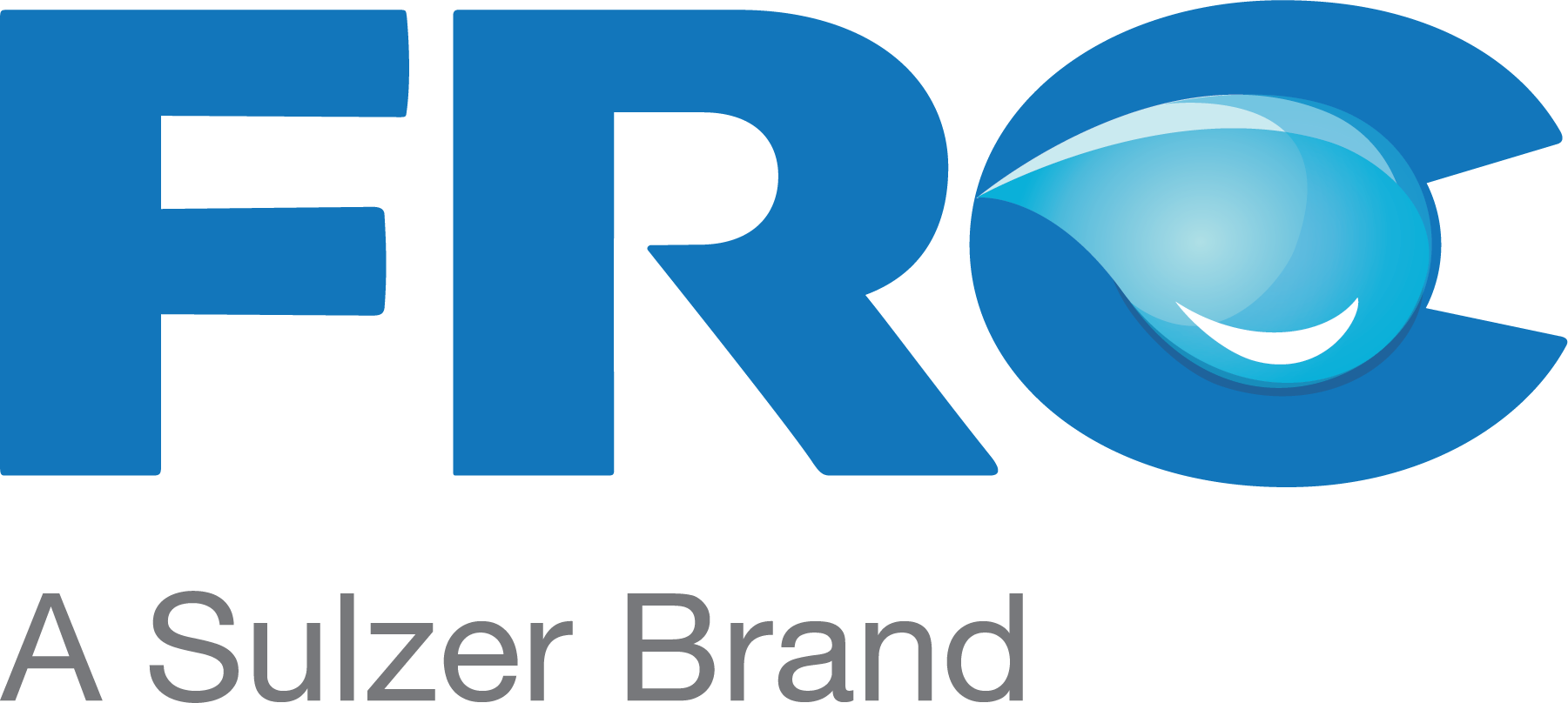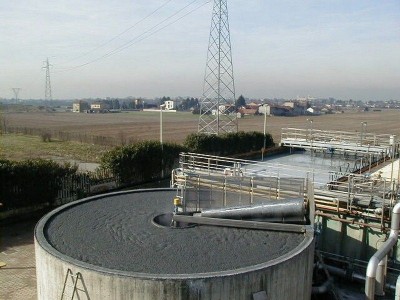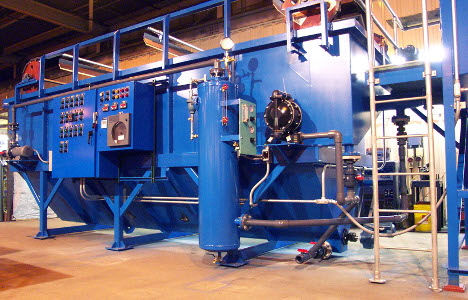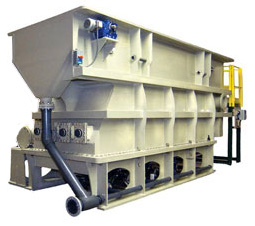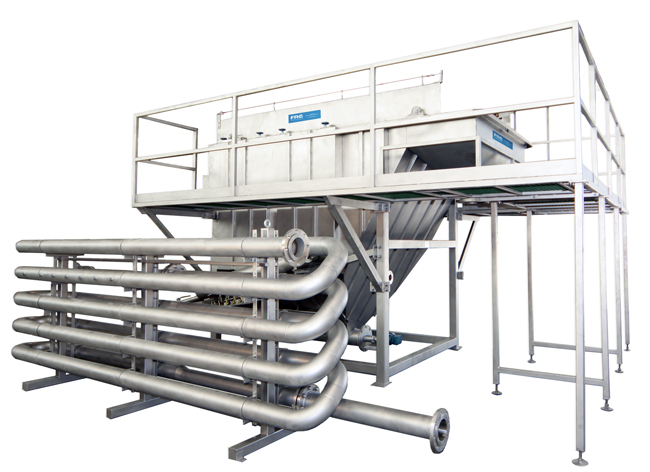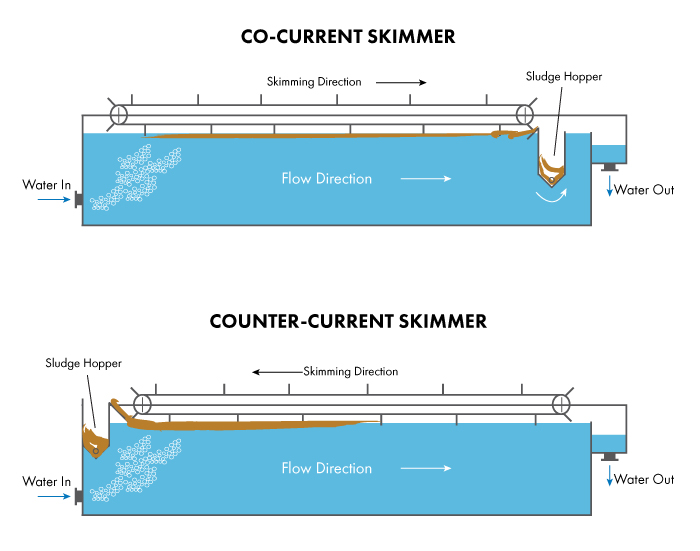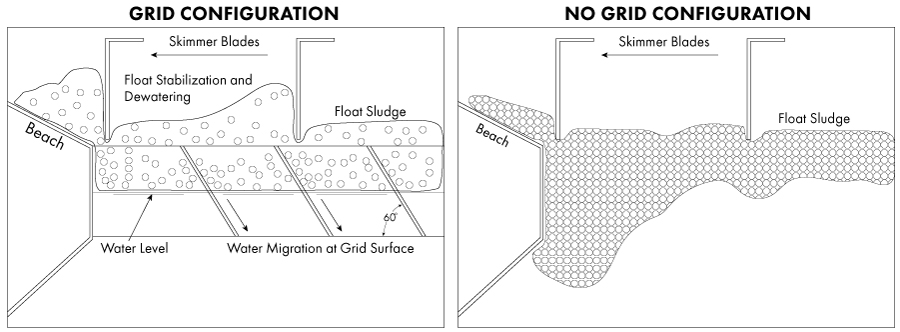If you haven’t read it yet, make sure you to read Part 1 of the Ultimate DAF System Buyer’s Guide
3. Materials of Construction
When you buy a DAF system, you want something that is going to hold up in a harsh environment. You’re going to use the thing for the foreseeable future and the last thing you want is something you have to replace because it didn’t hold up.
There are several options for materials of construction with regards to the tank structure, each with their own advantages and disadvantages. Let’s look at what’s on the market:
Concrete
Steel-reinforced concrete basins are typically used in large municipal wastewater treatment plants. Concrete DAF basins are sturdy and leak proof, but can be very expensive because of the required civil work involved, i.e. excavation, steel reinforcement, concrete forming, coating, etc. Since they can only be built in the location where they’re going to operate, concrete DAF basins are not often selected for use in industrial facilities.
Polypropylene
Some manufacturers prefer polypropylene because of its lower material cost, good strength and stiffness, and generally broad chemical resistance.
Significant problems arise when polypropylene is exposed to extreme temperatures or UV radiation. If placed outdoors, UV light from the sun causes tertiary carbon bond breakdown and results in discoloration and cracks.
Polypropylene will not hold its shape at temperatures above 260°F and it will crack at temperatures below 32°F. Refurbishing polypropylene tanks for reuse is rarely pursued as the material degrades over time. DAF manufacturers that use polypropylene generally warranty the tank structures for 10 years.
Epoxy-Coated Carbon Steel
Coated carbon steel offers the strength of steel and the general corrosion-resistance of an epoxy coating. Structures of this sort are particularly useful in applications with high Total Dissolved Solids (TDS). But for applications in the food industry, this material isn’t recommended because free fatty acids in floating sludge will eat through the epoxy coatings and rust the steel, compromising the tank’s structural integrity. Epoxy-coated carbon steel is commonly thought of as less expensive than stainless steel, however when constructed to provide the same structural strength and corrosion resistance as stainless, the cost-savings of coated carbon steel is negligible.
Stainless Steel
Stainless steel is used in DAF tank construction for a variety of reasons. Stainless steel resists rust formation because of a passive film of chromium oxide on its surface that blocks oxygen diffusion and corrosion. Stainless steel retains its strength between temperatures of -320°F to 1500°F, so it holds up in indoor and outdoor applications. Welders can easily make modifications to the material without needing to re-apply paint or other coatings. Even after decades of use, stainless steel tanks can be retrofitted and work for decades longer because the steel structure remains sound.
Stainless steel, however, does come at a higher price than some other materials and it is not particularly well-suited for applications with significant concentrations of chlorides, which could potentially cause pitting or corrosion.
Stainless steel DAF tanks retain a high resale value and many manufacturers are willing to buy them back, even after prolonged use.
4. Sludge Thickening Mechanisms
The purpose of a DAF system in the wastewater treatment process is to remove solid and oily contaminants. The trick to increased efficiency and cost-reduction is to get the DAF generating fluffy, thick sludge – not a watery slurry. Sludge thickness is a function of hydraulic, mechanical, and chemical processes – when they come together, engineered in a thoughtful manner, the results speak for themselves.
Co-Current vs. Counter-Current Skimming
The internal hydraulic flow patterns in a DAF system vary from manufacturer to manufacturer and by DAF configurations. DAF systems that employ plate packs often direct wastewater in a down-flow or cross-flow pattern so the following discussion has less relevance to this type of DAF unit. Open style DAF tanks, however, generally employ a flow-through or end-to-end hydraulic process so this conversation is very important.
When considering an open tank DAF system, take a good look at which direction the skimmer assembly rotates. Does it rotate in the same direction (co-current) as the hydraulic flow of the wastewater through the system? Or does it rotate against (counter-current) that flow? Here’s why it matters.
Say you’re looking at the side of an open style DAF tank that’s 40 feet long and 8 feet wide. Wastewater is fed into the DAF unit on the left side and exits out the right. As a layer of sludge begins to form at the water’s surface, the skimmer flights are going to start pushing that sludge in one of two directions. The co-current skimmer is going to push the sludge from left to right, the same direction as the wastewater flow. The counter-current skimmer folds the sludge back over the flow from right to left. Still with me?
Now, consider where the sludge first begins to reach the surface of the water – is it near the inlet, middle, or outlet side of the tank? Most DAF systems hit the inlet stream of wastewater with whitewater immediately upon entry into the vessel, so sludge forms near the inlet side of the DAF tank. If sludge forms near the inlet side of the DAF tank, what good reason is there to co-currently push that sludge across the entire 40 foot length of the unit? It makes much more sense to use a counter-current skimmer to push the sludge a shorter distance.
Proponents of the co-current configuration would argue that while sludge is being pushed across the long length of a DAF system, it’s being thickened. However, field data and reviews from operators would argue the opposite. Skimming co-currently more frequently results in watery sludge, extra build-up of material near the sludge ramp, sludge splashing into the effluent chamber, and faster wear and tear on the skimmer motor and flights.
With open-style DAF systems, the counter-current skimmer consistently wins the performance battle, especially when an extra measure is taken to lock sludge in place when it reaches the surface of the water – more on that to follow.
Sludge Dewatering Grid
Another key mechanical feature of DAF systems that are engineered to generate the driest sludge possible is a static grid that sits at the surface of the water, commonly referred to as a Dewatering Grid.
A dewatering grid is a rectangular framework of angled steel plates that help lock sludge in place as it reaches the surface of the water. As sludge accumulates in the dewatering grid, it is held in place until it reaches the point where the skimmer blades slice it off the top and start pushing it toward the sludge ramp. By allowing for a little retention time in the grid, float materials self-dewater before they’re skimmed away. This results in higher dry solids content, or less-watery sludge.
Without the grid the skimmer blades start pushing sludge along before it has had any time to dewater in place. Often times what happens is that the float begins to accumulate right near the sludge ramp and can be forced back down into the water, completely undoing any dewatering that may have occurred before removal. The diagrams below illustrate this point.
So what’s the big deal with watery sludge? As long as the discharge water meets the requirements we’re good right? Well, that depends on how important saving money is to your operation. More water in sludge means more required storage capacity, bigger dewatering equipment, and more chemical expenses on re-processing filtrate water (the water that separates out of sludge after dewatering) through the DAF system. You have everything to gain by going with a DAF system that’s engineered to produce drier sludge. Ask the DAF vendor how their design helps generate drier, thicker sludge. What mechanisms do they provide to allow operators to adjust sludge thickness?
Keep reading: Part 3 of the Ultimate DAF System Buyer’s Guide
